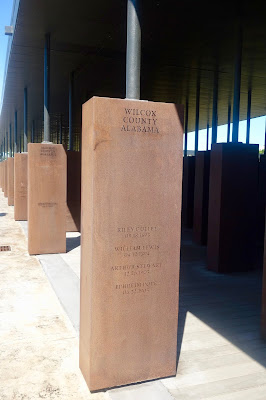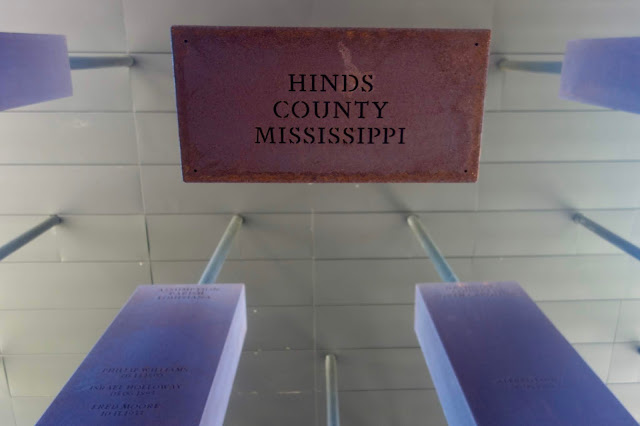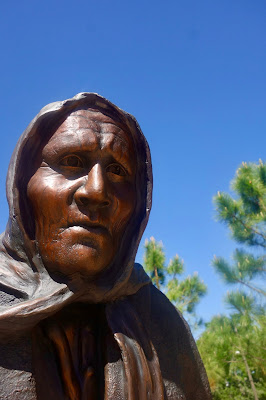Despite the pastoral entrance, the National Memorial for Peace and Justice in Montgomery, the centerpiece of our road trip, delivered an extraordinary gut punch.
Statues of enslaved African Americans in chains sculpted by Kwame Akoto-Bamfo plunge visitors into the horrors of the not-so-distant past.
Half the memorial is hidden from view on a rise.
Eight hundred monuments, each about the size of a man, comprise the memorial. They're inscribed at the top with the names of counties throughout America--some as far north as Maryland--where the Equal Justice Initiative has documented lynchings. Individual victims' names--signifying more than 4,000 black necks broken--are listed beneath.
As you walk deeper inside, you gradually find yourself standing under the monuments, hanging from above as if noosed human beings. County names appear on the bottom, too, reminding you how pervasive the practice was.
The "offenses" of the lynching victims, mostly men, beggar belief.
In aggregate, the monuments indict, powerfully. "Our country's national crime is lynching," observed Ida. B. Wells, an early Civil Rights activist who was freed by the Emancipation Proclamation during the Civil War.
A water wall memorializes anonymous victims.
The language of Toni Morrison exhorts as it scalds.
The perfect symmetry of the memorial's design belies the racial terror it commemorates.
Each monument has a double, arrayed like coffins a short distance away. The Equal Justice Initiative has invited counties to "reclaim" these monuments and erect them locally in an effort to acknowledge the past and achieve some kind of reconciliation. Monroe and Montgomery counties are among the hundreds who have yet to do so. The home of To Kill A Mockingbird alone lynched 17 African Americans.
It came as a bittersweet relief that my birthplace, El Paso, was not included among the Texas counties. The same can't be said of the Florida county where I likely will die: two men lynched less than a century ago.
A special grove of young trees on the site is named after Ida Wells.
A sculpture by Dana King pays tribute to the women who sustained the Montgomery bus boycott, which lasted a little more than a year in the mid 1950s. It led to a Supreme Court decision that desegregated public transportation in the Deep South.
Another sculpture by Hank Willis Thomas, set against the backdrop of the Montgomery skyline, reminds visitors that the struggle for justice continues.
A map depicting the density of racial terror in Alabama hangs in the visitor's center across the street.
The center also displays earth obtained from beneath the lynchings in glass jars.
























Powerful and profoundly disturbing. Thank you for sharing
ReplyDelete